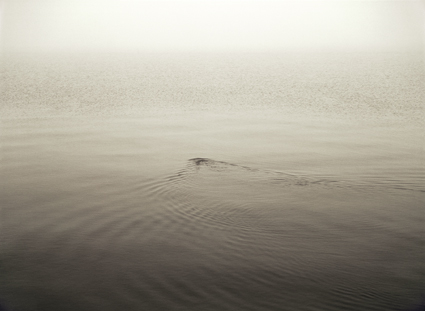
Leave Room For The Viewer – The Story Behind The Photograph
Condensation III, Rockland, Maine, 2001
One second it was there and the next it wasn’t and in a few seconds even the ripples it created were gone. It was there in this shot, but I took it out. What was it? I’ll leave that to your imagination. It’s more interesting that way. In moments like this our minds run wild. Our still childlike imagination takes over and plays. Stone? Fish? Bird? Snake? Squid? Sea monster? Mermaid? Diver? Now things are getting interesting! In the end, maybe this image really isn’t one thing. Maybe it’s become many. And maybe that’s more interesting. I know what it was when I made the picture – and that’s a limitation I’ve had to challenge myself to overcome to see more in this picture. When people try to solve the mystery together the image becomes even more interesting, to both them and me. We all want to bring more to our creations – and we don’t have to do all that work by ourselves. Part of that ‘more’ is what other people bring to it.
Everybody loves a mystery. Director J J Abrams’ love of mysteries is evident in his many television shows and movies and his mastery of mysteries is evident by their widespread success. He knows some mysteries are best left unsolved. “To be continued” … In his TED talk The Mystery Box and he wisely states “Ultimately the mystery box is all of us.”
How many great inventions have been repurposed for uses than they were originally intended for? Gunpowder was first born as an elixir of immortality. The rat poison Warfarin became a blood thinner. A telephone conversation recorder became a musical record player. Viagra was invented to cure heart disease but had an unexpected side effect of making other things hard. And what can’t you do with duct tape? The inventions that survived adapted. The ones that thrived left room for their users to bring about unexpected evolution. They grew stronger with user participation and innovation. You can’t guarantee that this will occur but you can hope it will and you can leave room for it to happen both in your plans and your creations.
There’s always a balancing act between holding to your original course and modifying it after weighing viewers’ responses. Consider putting your creations to the test with a select audience before releasing them to wider audiences. If you do, seek enough feedback from a variety of relevant sources and weigh it appropriately.
There’s a fine line between leaving too little room for the viewer (when what’s produced is uni-dimensional and predictable) and leaving too much (when not enough is brought to the picture and what’s created seems uncommitted). Find it and you’ll find uncommon success and new opportunities for growth.
Questions
How many ways can you leave room for user participation?
How many ways can you stimulate user participation?
Where is the line between too little room for the viewer and too much?
How much or how little does something need to resolve for it to be complete?
When is it best to switch gears based on user feedback?
Find out more about this image here.
View more related images here.
Read more The Stories Behind The Images here.



No Comments